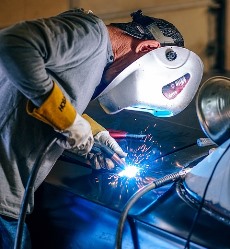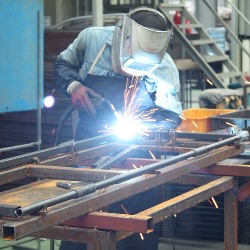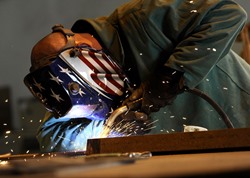How to Enroll In the Right Welder Degree Program near Kihei Hawaii
 Locating the ideal welder technical school near Kihei HI is an important first step to starting your new occupation as a professional welder. But since there are numerous schools to select from, how do you determine which ones to consider? And more notably, once you have fine tuned your choices, how do you select the best one? A number of prospective students begin by reviewing the schools that are nearest to their residences. When they have found those that are within driving distance, they gravitate toward the least costly one. Yes, location and tuition cost are crucial concerns when examining welder vocational schools, but they are not the only ones. Other considerations include such things as accreditation, reputation and job placement rates. So before beginning your search for a trade school to become a welder, it’s prudent to establish a list of qualifications that your chosen school must have. But before we delve into our due diligence checklist, let’s talk a little bit about how to become a welder.
Locating the ideal welder technical school near Kihei HI is an important first step to starting your new occupation as a professional welder. But since there are numerous schools to select from, how do you determine which ones to consider? And more notably, once you have fine tuned your choices, how do you select the best one? A number of prospective students begin by reviewing the schools that are nearest to their residences. When they have found those that are within driving distance, they gravitate toward the least costly one. Yes, location and tuition cost are crucial concerns when examining welder vocational schools, but they are not the only ones. Other considerations include such things as accreditation, reputation and job placement rates. So before beginning your search for a trade school to become a welder, it’s prudent to establish a list of qualifications that your chosen school must have. But before we delve into our due diligence checklist, let’s talk a little bit about how to become a welder.
Welder Degree and Certificate Training Classes
 There are several options available to obtain training as a welder in a trade or technical school. You can receive a a certificate, a diploma or an Associate Degree. Bachelor Degrees are available in Welding Engineering or Welding Technology, but are more advanced courses than most journeyman welders will need. Some programs are also made available along with an apprenticeship program. Below are brief summaries of the most prevalent welding programs offered in the Kihei HI.
There are several options available to obtain training as a welder in a trade or technical school. You can receive a a certificate, a diploma or an Associate Degree. Bachelor Degrees are available in Welding Engineering or Welding Technology, but are more advanced courses than most journeyman welders will need. Some programs are also made available along with an apprenticeship program. Below are brief summaries of the most prevalent welding programs offered in the Kihei HI.
- Diploma and Certificate Programs are generally offered by technical and trade schools and take about 1 year to complete. They are more hands-on training in scope, fashioned largely to develop welding skills. They can provide a good foundation for a new journeyman or apprentice welder, or additional skills for experienced welders.
- Associate Degree Programs will take 2 years to finish and are most often offered by community colleges. An Associate Degree in Welding Technology furnishes a more extensive education than the certificate or diploma while still supplying the foundation that prepares students to enter the workforce.
A number of municipalities and states do have licensing requirements for welders, so be sure to find out for your location of future employment. As needed, the welder school you choose should prepare you for any licensing examinations that you will need to pass in addition to supplying the suitable training to become a professional welder.
Welder Certification Options
 There are multiple institutions that provide welder certifications, which test the skill level and knowledge of those applying. A large number of Kihei HI employers not only demand a degree or certificate from an accredited welding program, but also certification from a highly regarded organization like the American Welding Society (AWS). A variety of certifications are available based on the kind of work that the welder does. Just some of the skills that certification can attest to are the welder’s ability to
There are multiple institutions that provide welder certifications, which test the skill level and knowledge of those applying. A large number of Kihei HI employers not only demand a degree or certificate from an accredited welding program, but also certification from a highly regarded organization like the American Welding Society (AWS). A variety of certifications are available based on the kind of work that the welder does. Just some of the skills that certification can attest to are the welder’s ability to
- Operate in compliance with specific codes
- Work with specified metal thicknesses
- Work with certain types of welds
- Work according to contract specifications
As already mentioned, many cities, states or local municipalities have licensing mandates for welders. Of those mandating licensing, many additionally require certification for various types of work. Certification is also a means to prove to employers that you are an extremely skilled and knowledgeable welder. So just as with licensing, check the requirements for your local area and make certain that the welding tech school you select preps you for certification as needed.
What to Ask Welder Trade Programs
 Once you have chosen the credential you would like to obtain, a certificate, diploma or degree, you can begin to assess schools. As you can imagine, there are many welder vocational and trade schools in the Kihei HI area. That’s why it’s important to determine in advance what qualifications your chosen school must have. We have already covered two significant ones that most people consider first, which are location and tuition cost. As mentioned, although they are very important qualifications, they are not the only ones that should be looked at. After all, the program you pick is going to provide the instruction that will be the foundation of your new vocation as a welder. So following are some additional factors you might want to consider before picking a welding vocational school.
Once you have chosen the credential you would like to obtain, a certificate, diploma or degree, you can begin to assess schools. As you can imagine, there are many welder vocational and trade schools in the Kihei HI area. That’s why it’s important to determine in advance what qualifications your chosen school must have. We have already covered two significant ones that most people consider first, which are location and tuition cost. As mentioned, although they are very important qualifications, they are not the only ones that should be looked at. After all, the program you pick is going to provide the instruction that will be the foundation of your new vocation as a welder. So following are some additional factors you might want to consider before picking a welding vocational school.
Accreditation. It’s essential that the welder vocational school you pick is accredited by either a regional or a national organization. There are 2 basic kinds of accreditation. The school may receive Institutional Accreditation based on all of their programs. Programmatic Accreditation is based on a single program the school has, for example Welding Technology. So make certain that the program you select is accredited, not just the school alone. Additionally, the accreditation should be by a U.S. Department of Education acknowledged accrediting agency, for example the Accrediting Commission of Career Schools and Colleges of Technology (ACCSCT). In addition to helping ensure that you obtain an excellent education, the accreditation may also assist in securing financial assistance or student loans, which are in many cases not offered in Kihei HI for non-accredited schools. Also, for those states or local governments that mandate licensing, they may require that the welder training program be accredited also.
Apprenticeship and Job Placement Programs. A large number of welder certificate or degree programs are provided in conjunction with an apprenticeship program. Some other schools will help place you in a job or an apprenticeship upon graduation. Ask if the schools you are looking at help in placing students in apprenticeships or have a job assistance program. These schools should have partnerships with local unions and various metal working businesses to which they can refer their students. Older schools may have a more substantial network of graduates that they can rely upon for referrals. These programs can help students find employment and establish associations within the Kihei HI welding community.
Completion and Job Placement Rates. The completion rate is the portion or percentage of students that start an academic program and complete it. It’s important that the welder school you choose has a high completion rate. A low rate could indicate that the students who enrolled in the program were unhappy with the instruction, the teachers, or the facilities, and dropped out. The job placement rate is also a good indicator of the quality of training. A high job placement rate will not only affirm that the school has an excellent reputation within the trade, but additionally that it has the network of Kihei HI employer relationships to assist students obtain apprenticeships or employment upon graduation.
Up-to-date Facilities and Equipment. Once you have decreased your selection of welding schools to 2 or 3 options, you should consider visiting the campuses to evaluate their facilities. Verify that both the facilities and the equipment that you will be taught on are modern. In particular, the training equipment should be comparable to what you will be working with on the job. If you are unsure what to look for, and are currently in an apprenticeship program, consult with the master welder you are working under for guidance. If not, ask a local Kihei HI welding professional if they can give you a few suggestions.
School Location. Although we previously briefly covered the relevance of location, there are a couple of additional issues that we need to deal with. You should bear in mind that unless you can relocate, the welding school you select needs to be within driving distance of your Kihei HI home. If you do opt to enroll in an out-of-state school, besides moving expenses there might be higher tuition fees for out-of-state residents. This is particularly the case for welding certificate programs offered by community colleges. Furthermore, if the school provides a job placement or apprenticeship program, most likely their placements are within the school’s regional community. So the location of the school needs to be in an area or state where you subsequently will wish to work.
Smaller Classes. One-on-one training is important for a hands-on trade such as welding. It’s possible to get overlooked in larger classes and not get much one-on-one instruction. Find out what the typical class size is for the welder programs you are reviewing. Ask if you can attend some classes so that you can observe just how much personal attention the students are receiving. While there, talk with a few of the students and get their feedback. Similarly, chat with a couple of the trainers and find out what their welding experience has been and what credentials and certifications they hold.
Convenient Class Scheduling. Lots of folks learn a new trade while still employed at their current job. Confirm that the class schedules for the schools you are looking at are convenient enough to satisfy your needs. If you can only attend classes in the evenings or on weekends near Kihei HI, verify that the schools you are considering provide those alternatives. If you can only attend part-time, confirm that the school you pick offers part-time enrollment. Also, check to see what the protocol is to make up classes should you miss any because of illness, work or family circumstances.
Online Welding Schools
 Welding is truly a hands-on kind of vocation, and therefore not very suitable for training online. Having said that, there are a small number of online welding courses offered by certain community colleges and technical schools in the greater Kihei HI area that can be credited toward a degree or certificate program. These classes mainly cover such topics as reading blueprints, safety,, and metallurgy. They can help give a novice a foundation to start their training and education. However, the most critical point is that you can’t learn how to weld or handle welding materials unless you actually do it. Obviously that can’t be performed online. These skills must be learned in an on-campus setting or in an apprenticeship. Online or distance learning is more appropriate for experienced welders that want to advance their expertise or perhaps attain a more advanced degree. So if you should come across an online welding degree or certificate program, be extremely cautious and make certain that the larger part of the training is done on campus or in a workshop type of setting.
Welding is truly a hands-on kind of vocation, and therefore not very suitable for training online. Having said that, there are a small number of online welding courses offered by certain community colleges and technical schools in the greater Kihei HI area that can be credited toward a degree or certificate program. These classes mainly cover such topics as reading blueprints, safety,, and metallurgy. They can help give a novice a foundation to start their training and education. However, the most critical point is that you can’t learn how to weld or handle welding materials unless you actually do it. Obviously that can’t be performed online. These skills must be learned in an on-campus setting or in an apprenticeship. Online or distance learning is more appropriate for experienced welders that want to advance their expertise or perhaps attain a more advanced degree. So if you should come across an online welding degree or certificate program, be extremely cautious and make certain that the larger part of the training is done on campus or in a workshop type of setting.
Attending a Welding School in Kihei HI?
If you have decided to enroll in a welder training program in the Kihei Hawaii area, you may find the following information both informative and helpful about the location of your new school campus.
Kihei, Hawaii
According to the United States Census Bureau, the CDP has a total area of 11.7 square miles (30.2 km2), of which 9.3 square miles (24.0 km2) is land and 2.4 square miles (6.2 km2), or 20.44%, is water.[3] It is considered to be the South Side of Maui, located on the leeward side of Haleakala. The climate is arid, receiving no more than 10 inches (250 mm) of rain per year.
Although its official city designation is Wailuku, the Kīhei Junction Park and Ride lot is a frequently-used commuter parking lot at the corner of highway 310 (North Kihei Road) and highway 30 (Honoapi'ilani Highway) at coordinates 20.8099479,-156.51417[4] There is no public bus service that stops here; however, it is located near Ma 'alaea Harbor Village, where there is a public transportation stop.[5] It's primarily used for hikers, bicyclists and ride sharers looking for a meeting place that is centrally located between Kīhei, Lahaina and Wailuku. There's no charge to park; the lot is unattended.
As of the census[6] of 2000, there were 16,749 people, 6,170 households, and 3,813 families residing in the CDP. The population density was 1,648.6 people per square mile (636.5/km2). There were 9,170 housing units at an average density of 902.6 per square mile (348.5/km2). The racial makeup of the CDP was 47.76% White, 6.74% African American, 0.48% Native American, 24.72% Asian, 7.85% Pacific Islander, 1.58% from other races, and 16.87% from two or more races. Hispanic or Latino of any race were 1.52% of the population.
Select the Right Welding Vocational Program Kihei HI
Picking the ideal welder school will undoubtedly be the most important decision you will make to start your new career. You originally stopped by our website because you had an interest in Becoming A Certified Welder. However, as we have discussed in this article, there are a number of factors that you will need to evaluate and compare among the programs you are looking at. It’s a necessity that any welder school that you are evaluating includes a considerable amount of hands-on training. Classes need to be smaller in size and each student should have their personal welding machine to train with. Classroom education needs to provide a real-world frame of reference, and the training program should be up-to-date and conform with industry standards. Training programs vary in duration and the type of credential provided, so you will have to determine what length of program and certificate or degree will best satisfy your needs. Every program provides different options for certification also. Perhaps The ideal approach to research your final list of schools is to check out each campus and talk with the faculty and students. Take the time to attend some classes. Inspect the campus and facilities. Make sure that you are confident that the program you select is the best one for you. With the right training, effort and dedication, the final outcome will be a new career as a professional welder in Kihei HI.
